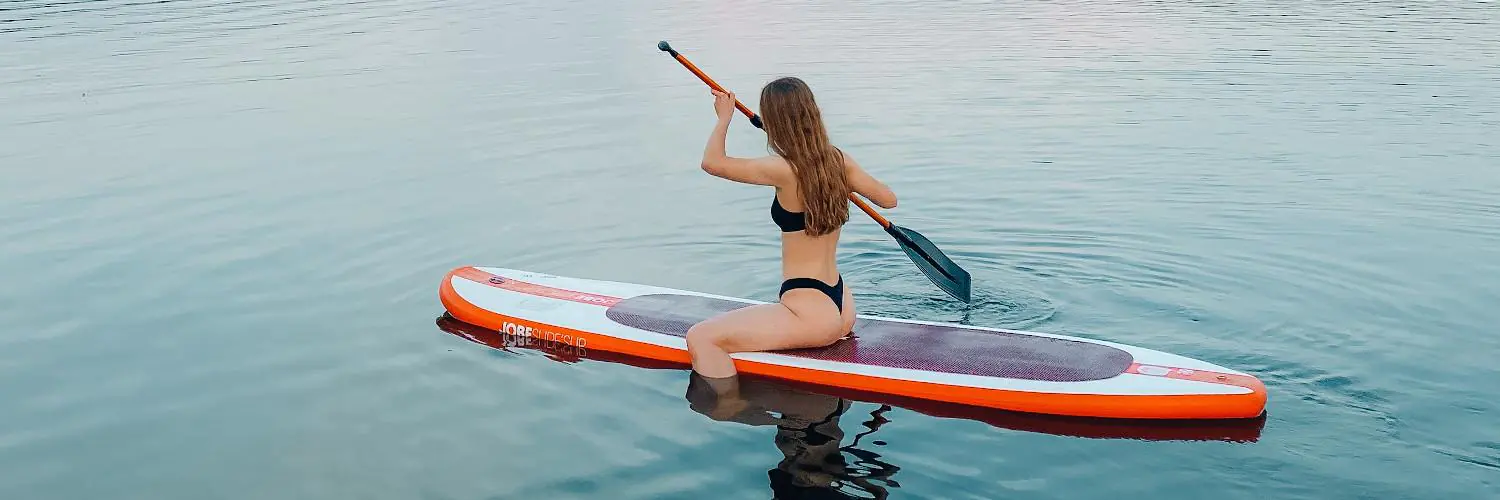When selecting a stand-up paddle (SUP) board, understanding its weight limit is crucial. The weight limit of a paddle board indicates the amount of weight it can support while maintaining performance and stability. This limit is determined by factors such as the board’s volume, dimensions, and construction. For example, inflatable paddle boards can typically support weights between 285 and 500 pounds. This capacity must include not only the paddler’s weight but also any additional cargo, such as gear for touring, fishing, or yoga.
The weight limit plays a significant role in how a paddle board behaves on the water. Boards exceeding their weight capacity become less stable, difficult to maneuver, and may even capsize. In contrast, a board with an appropriate weight limit relative to the user’s weight maintains its buoyancy and stability, which is particularly important for activities like surfing and yoga that require a greater degree of balance. The dimensions of the board, including its length and width, contribute to its suitability for various activities. Shorter boards, generally easier to maneuver, are preferred for surfing, while longer boards offer better tracking and speed for touring purposes.
Paddle boarding enthusiasts must consider the weight limit as a key aspect when choosing the right board. Inflatable paddle boards provide the flexibility and a higher weight capacity suitable for different users and activities, while solid boards tend to offer increased stability but may have a lower weight threshold. Regardless of the board’s material, matching the paddler and any additional load with the SUP’s weight limit is essential for a safe and enjoyable experience on the water.
Table of Contents
Understanding SUP Weight Limits
When choosing a stand-up paddleboard (SUP), it is essential to consider its weight capacity, which determines how much load the board can handle without compromising performance or safety.
Significance of Weight Capacity
The weight capacity of a SUP is a critical specification as it affects the board’s buoyancy and stability. Exceeding the maximum weight capacity can lead to decreased performance, as the board sits lower in the water, potentially affecting maneuverability. More importantly, staying within the recommended weight limit is crucial for safety to prevent the board from sinking and to mitigate the risk of accidents.
Factors Affecting Weight Limits
- Board Volume and Buoyancy: The volume of a SUP, typically measured in liters, directly impacts its buoyancy. A larger volume indicates a higher buoyancy, which can support more weight.
- Board Material and Construction: Inflatable paddle boards have varying weight limits but often support between 285 and 500 pounds, depending on their construction. Solid boards generally have lower limits and may support around 200 to 300 pounds.
- Board Size and Dimensions: The length, width, and thickness of a SUP can influence the practical weight limit. Larger boards tend to accommodate heavier weights. For instance, a board that is 10 feet long and 32 inches wide may have a different weight capacity compared to one that is 11 feet long and 36 inches wide.
The following table provides standard weight limits based on board length:
| Board Length | Average Weight Limit |
|---|---|
| 10 feet | 200 to 250 pounds |
| 11 feet | 250 to 300 pounds |
| Multi-paddler board (e.g., Bluefin Mammoth) | Up to 1430 pounds |
It’s important to note that these values are averages and the actual weight limit can vary by brand and model. For precise limits, one should refer to the manufacturer’s specifications. It is also worth mentioning that the weight limit is usually provided in pounds and can be converted to kilograms (1 pound ≈ 0.45 kilograms) for international understanding.
Selecting the Right SUP for Your Needs
Selecting the appropriate stand-up paddleboard (SUP) is crucial for ensuring a perfect balance between stability and performance. It is essential to consider board volume and the specific types of SUPs to accommodate different weight capacities.
Board Volume and Thickness
The volume of a SUP board is a key determinant of its buoyancy and stability, and is measured in liters. An increase in volume equates to more weight the board can support. Board thickness contributes to volume; therefore, a thicker board generally supports more weight. An average all-around SUP will have significant volume to provide support for beginners and individuals looking for stability. For instance, a standard all-around SUP might range from 150 to 220 liters in volume.
SUP Types and Their Weight Capacities
Each SUP type caters to specific activities and comes with varied weight limits:
-
All-Around SUPs: These versatile boards usually range between 10 to 11 feet in length and 31 to 35 inches in width. They can typically support an average weight limit ranging from 200 to 300 pounds.
-
Touring Paddle Boards: Designed for long distances and often sturdier, these boards can fall in the range of 12 to 14 feet long, with an average weight capacity of around 300 to 400 pounds.
-
Yoga SUPs: They offer wider decks for greater balance and typically support similar weights to all-around boards due to their focus on stability.
-
Racing SUPs: Built for speed and performance, racing boards are narrower and can vary widely in their volume and weight support. They are generally less stable than all-around or yoga SUPs.
-
Surfing Paddle Boards: These shorter and maneuverable boards are fashioned for waves and are not intended to carry as much weight as their touring or all-around counterparts.
-
Inflatable SUPs: These SUPs are generally slightly less rigid than solid boards but have come a long way in terms of stability and can support weights comparable to solid boards depending on their design and size.
Understanding the relationship between board size, volume, and weight limits is pivotal in choosing the correct stand-up paddleboard to match an individual’s needs, whether it’s for casual paddling, touring, or competitive pursuits.
How to Calculate the Appropriate SUP Size
Choosing the right SUP size is vital for optimal performance on the water. Board dimensions and weight significantly influence stability, speed, and maneuverability.
Volume Calculation and Board Dimensions
The volume of a stand-up paddleboard (SUP) is a key factor in determining its buoyancy and stability. Volume is calculated in liters and gives a paddler a quantitative measure to help them find a suitable board size. The dimensions of a board—its length, width, and thickness—play a crucial role in this calculation. As a general guideline:
- Length: Affects glide and speed, with longer boards (12-14 feet) favored for racing due to their superior glide, whereas shorter boards (9-11 feet) are more maneuverable.
- Width: Impacts stability, with wider boards (31-35 inches) offering more balance, which is especially helpful for beginners. Narrower boards (26-30 inches) are typically faster and better suited for experienced paddlers looking for speed.
- Thickness: Relates directly to volume, affecting overall weight capacity. Typical SUPs range from 4-6 inches in thickness.
The appropriate size for a user depends not only on the activity they intend to use the SUP for but also on their body weight and skill level.
Weight and Its Impact on Board Performance
The weight of the paddler is paramount when selecting a SUP, as each board has a maximum weight capacity that ensures proper performance. Heavier individuals require boards with higher volume for adequate support and stability, whereas lighter paddlers can opt for lower-volume boards which offer more speed and agility.
Performance factors include:
- Paddler Weight: Directly influences the volume requirements for a board. Heavier paddlers should look for a higher volume to maintain floatation and stability, while lighter paddlers can use lower volume boards for better performance.
- Board Performance: A board’s performance is a balance between its ability to remain stable (wider, higher volume) and its speed and glide efficiency (longer, narrower).
Paddlers must consider their own weight in conjunction with a SUP board’s dimensions to select a size that will deliver the right balance of stability, maneuverability, and speed, enhancing their overall experience on the water.
Maximizing SUP Performance and Longevity
To prolong the life of a SUP and ensure peak performance, careful attention must be given to weight distribution and cap.
Handling Extra Gear and Passengers
When loading a SUP with extra gear or accommodating passengers such as pets, one should distribute weight evenly across the board’s surface. This maintains balance and stability, which are crucial for efficient paddling. It’s advisable to secure gear near the board’s center and keep heavier items as low as possible. This lowers the center of gravity and minimizes resistance against the water, leading to smoother navigation.
- Key Consideration for Gear: Store in a waterproof sack attached to the deck bungee.
- Pets: Train them to sit still at the board’s center; this maximizes stability.
Avoiding Overloading and Its Consequences
Overloading a SUP not only hampers performance but can also lead to premature material fatigue, reducing its longevity. The significance of adhering to the weight limit set by manufacturers cannot be overstated; it’s formulated to ensure the board’s structural integrity and optimal functioning. Exceeding this limit can result in a submerged tail or nose, increased drag, and potential capsizing — a dangerous outcome.
- Visible Warning Signs: The board sits lower in the water, becomes sluggish, or handles poorly.
- Risk Mitigation: Regularly check that the load is within the acceptable range, especially when adding gear or passengers during a trip.
Frequently Asked Questions
Exploring the intricacies of paddle board weight limits ensures that enthusiasts can select the right SUP for their weight and the boards intended use. It is essential to comply with the manufacturer’s recommendations for safety and optimal performance.
Weight Limit FAQs for Paddleboards
What is the average weight capacity of a paddleboard?
Paddle boards typically have an average weight capacity ranging from 200 to 500 pounds. The specific limit can vary based on the type and size of the paddleboard, with inflatable models supporting between 285 and 500 pounds and solid paddleboards often having a lower capacity.
Are there different weight limits for different types of paddleboards?
Yes, there are different weight limits. For instance:
- Surfing SUPs generally support less weight, ideal for agility and speed.
- Fishing SUPs typically offer a higher weight capacity to accommodate gear and stable casting.
How does the weight limit of an inflatable paddle board compare to a solid paddle board?
In general, inflatable paddle boards provide a good weight capacity, potentially holding between 285 to 500 pounds. They are designed to be portable yet robust. Solid paddleboards might offer increased stability, but their weight limits can vary, usually providing a sturdy experience without the high weight capacity of inflatable options.
Why is it important to adhere to the paddleboard weight limit?
Staying within the paddleboard’s weight limit is crucial for safety and maintaining the integrity of the board. Exceeding the maximum weight limit can lead to:
- Decreased stability and maneuverability
- Increased risk of board damage
- Suboptimal paddling experience
Do accessories affect the paddleboard’s weight capacity?
Accessories do affect a paddleboard’s overall weight capacity. Items such as life jackets, coolers, or fishing gear count towards the maximum weight limit. Users must account for the weight of all accessories to ensure they do not surpass the paddle board weight limit.
Where can I find a paddleboard’s weight limit?
A paddleboard’s weight limit is typically stated by the manufacturer. This information can be found:
- On a label on the paddleboard itself
- In the product’s user manual
- On the manufacturer’s website, under product specifications








